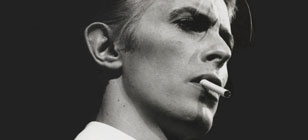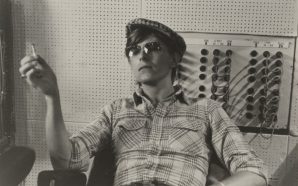DETAILS
Album: “Heroes”
Released: 6 January 1978
Label: RCA – PB 1190 / PC 1204 (12″ Spain) / JD 11204 (12″ US promo)
Single B-side: ‘Sense of Doubt’
Recorded: Hansa Studio by the Wall, West Berlin, July–August 1977
Length: 3:32 / 5:18 (12″ extended version)
Production: David Bowie, Tony Visconti
Musicians: David Bowie (vocals, piano), Robert Fripp (lead guitar), Carlos Alomar (rhythm guitar), George Murray (bass guitar), Dennis Davis (drums), Brian Eno (synthesizer, guitar treatments), Antonia Maass (backing vocals)
STORY
The story behind ‘Beauty And The Beast’
‘Beauty And The Beast’ was released as the follow-up single to ‘”Heroes”‘ on 6 January 1978. Considered an unconventional choice for release, it reached only #39 in the UK, and failed to chart in the US, despite being augmented by a promo 12″ single featuring Bowie’s earlier US No. 1 hit ‘Fame’ on the B-side.
Featuring Robert Fripp on lead guitar, his guitar is apparently his first take made straight after arriving at Berlin’s Hansa studio. The song opens with sporadic blips of percussion and synthesizer, building rapidly via a thumping piano, insistent drumming and Bowie’s crescendo howl. The intro bears a resemblance to that of Neu!’ s 1975 track ‘Hero’, but otherwise this is very much a Bowie song.
Although Bowie never discussed the lyric at any length, it seems likely that ‘Beauty And The Beast’ operates in part as a recantation of the ugly underside of his Thin White Duke phase, and an exploration of the undesirable inner character unleashed during his drink and drug binges: “There’s slaughter in the air, protest in the wind, someone else inside me, someone could get skinned … I wanted to believe me, I wanted to be good”.
In the light of his later remark that Berlin “brought me back in touch with people” and “got me back on the streets”, the song might also be interpreted as an expression of gratitude and relief at his escape from Los Angeles: “Nothing will corrupt us, nothing will compete / Thank God heaven left us standing on our feet.” However, the song offers a salutary lesson in the danger of over-analysing Bowie’s lyrics. The line “someone fetch a priest”, which it would be tempting to interpret as a confessional impulse or a testimony of spiritual rebirth, actually derives from “someone fuck a priest”, Tony Visconti’s favourite expletive during the “Heroes” sessions.
The five-minute edit appeared on a 12” promo in the US and Spain, although labelled the ‘Disco Version’, was merely an early instance of that forthcoming bane of the 1980s, the extended edit, using a simple splice to repeat the bridge and chorus.
Bowie only performed the song live on his 1978 Isolar II tour, with a version appearing on Stage.
WATCH
Performances of ‘Beauty And The Beast’
This live version of ‘Beauty And The Beast’ was recorded at the Nippon Budokan in Tokyo, Japan, on the 12 of December 1978, the last date of the 1978 Isolar II world tour.
LISTEN
LYRICS
‘Beauty And The Beast’ Lyrics
Weaving down a byroad,
singing the song
That’s my kind of highroad,
gone wrong
My-my
Smile at least
You can’t say no
to the Beauty and the Beast
Something in the night
Something in the day
Nothing is wrong but darling
Something’s in the way
There’s slaughter in the air
Protest on the wind
Someone else inside me
Someone could get skinned, how?
My-my
Someone fetch a priest
You can’t say no
to the Beauty and the Beast
Darling
My-my
You can’t say no
to the Beauty and the Beast
(Weakling)
My-my
You can’t say no
to the Beauty and the Beast
I wanted to believe me
I wanted to be good
I wanted no distractions
Like every good boy should
My-my
Nothing will corrupt us
Nothing will compete
Thank god heaven left us
Standing on our feet
My-my
Beauty and the Beast
My-my
Just Beauty and the Beast
You can’t say no
to the Beauty and the Beast
Darling
My-my
My
My-my
My
ARTWORK
‘Beauty And The Beast’ Artwork
The cover photo for the single echoed that used on the album “Heroes”. Taken by Masayoshi Sukita, it was inspired by the painting Roquairol by German artist Erich Heckel, in which the subject strikes a similar pose.













